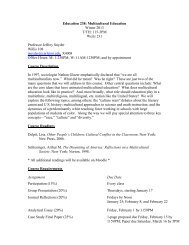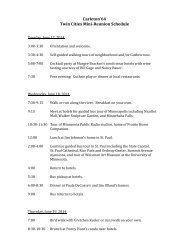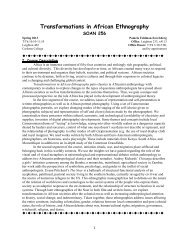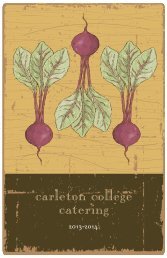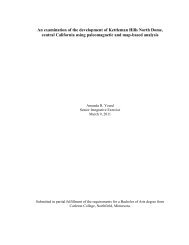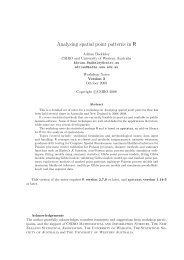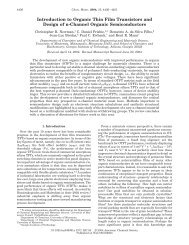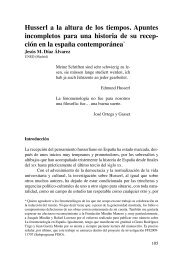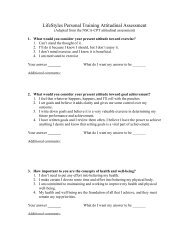babababababababababababababab the druid ... - Carleton College
babababababababababababababab the druid ... - Carleton College
babababababababababababababab the druid ... - Carleton College
Create successful ePaper yourself
Turn your PDF publications into a flip-book with our unique Google optimized e-Paper software.
though in France <strong>the</strong>se “Prechristian Christians” tended to be patriotic<br />
heroes resisting foreign invasion, while <strong>the</strong>ir English counterparts<br />
were <strong>the</strong> greatest mystics in history.<br />
In London, throughout <strong>the</strong> century, “Druid” groups appeared along<br />
with Rosicrucian and Freemasonic organizations. In 1781 c.e., Henry<br />
Hurle set up The Ancient Order of Druids (AOD), a secret society<br />
based on Masonic patterns (not surprising, since Hurle was a carpenter<br />
and house builder). This group, like most of <strong>the</strong> similar mystic<br />
societies form at <strong>the</strong> time, was heavily influenced by Jacob Boehme.<br />
Jacob Boehme, 1675-1724 c.e., was a Protestant mystic, greatly involved<br />
with alchemy, hermeticism and Christian Cabala, as well as<br />
being a student of <strong>the</strong> famous Meister Eckhart. His mystical writings<br />
attempted to reconcile all <strong>the</strong>se influences and had a tremendous<br />
impact upon later generations of mystical Christians, Rosicrucians,<br />
Freemasons, and Theosophists.<br />
{“Overseas, <strong>the</strong> link between Deism, Masonry and Druidism was<br />
once again established, in <strong>the</strong> small town of Newburgh, New York.<br />
G. Adolf Koch has an entire chapter on “The Society of Druids” in<br />
his book Religion of <strong>the</strong> American Enlightenment. Deism and downright<br />
a<strong>the</strong>ism were popular during <strong>the</strong> 1780’s and 90’s among <strong>the</strong><br />
American intelligentsia, especially those who had supported <strong>the</strong><br />
American and French revolutions. In fact, a ra<strong>the</strong>r large number of<br />
<strong>the</strong> key political figures involved in both revolutions were Deistic<br />
Masons and Rosicrucians (see Neal Wilgus, The Illuminoids). Koch<br />
tells <strong>the</strong> story of <strong>the</strong> Newburgh Druids thusly:}<br />
{“Some Influential citizens of Newburgh had organized <strong>the</strong>mselves<br />
into an interesting radical religious body called “The Druid Society.”<br />
Like its sister organization, <strong>the</strong> Deistic Society in New York, it was a<br />
radical offshoot of an earlier and more conservative society. A Masonic<br />
lodge had been established in Newburgh in 1788, and it seems,<br />
as one attempts to piece toge<strong>the</strong>r <strong>the</strong> fragmentary facts, that as <strong>the</strong><br />
bro<strong>the</strong>rs, or at least a number of <strong>the</strong>m, became more and more radical<br />
in <strong>the</strong> feverish days of <strong>the</strong> French Revolution, <strong>the</strong> metamorphosis<br />
from Mason to Druid resulted. The Druids held <strong>the</strong>ir meetings in<br />
<strong>the</strong> room formerly occupied by <strong>the</strong> Mason and continued to use a<br />
ceremony similar to <strong>the</strong> Masonic. It is interesting to note, too, that as<br />
<strong>the</strong> Druid Society dies out contemporaneously with <strong>the</strong> end of Palmers’<br />
activities in New York City (he was a famous Deist of <strong>the</strong> time-PEIB),<br />
a new Masonic lodge was instituted in Newburgh in 1806.”}<br />
{“ Koch continues, “The question naturally arises as to why those<br />
apostate Masons chose <strong>the</strong> name of Druids. It seems that when <strong>the</strong>y<br />
abandoned Christianity, with which Masonry in America had not<br />
been incompatible, <strong>the</strong>y went back to <strong>the</strong> religion (as <strong>the</strong>y conceived<br />
of it—PEIB) of <strong>the</strong> ancient Druids who were sun worshippers. It was<br />
commonly believed at that time, by <strong>the</strong> radicals of course, that both<br />
Christianity and Masonry were derived from <strong>the</strong> worship of <strong>the</strong> sun..<br />
The Druids thus went back to <strong>the</strong> pure worship of <strong>the</strong> great luminary,<br />
<strong>the</strong> visible agent of a great invisible first cause, and regarded<br />
Christianity as a later accretion and subversion of <strong>the</strong> true faith, a<br />
superstition, in short, developed by a designing and unscrupulous<br />
priesthood, to put it mildly in <strong>the</strong> language of <strong>the</strong> day.” “}<br />
{“It appears that Thomas Paine, among o<strong>the</strong>r radicals of <strong>the</strong> time,<br />
was convinced that Masonry was descended from Druidism. Koch<br />
refers us to an essay by Pain, The Origin of Freemasonry, written in<br />
New York City in 1805. In this essay he mentions a society of Masons<br />
in Dublin who called <strong>the</strong>mselves Druids. The spectacular fantasies<br />
and conjectures that have been offered over <strong>the</strong> centuries to<br />
explain <strong>the</strong> origins of Masonry and Rosicrucianism will have to await<br />
ano<strong>the</strong>r article to be properly discussed. Suffice it to say for now that<br />
<strong>the</strong> sorts of Druidism with which <strong>the</strong> noble Paine and his friends<br />
might have been familiar were far more likely to have been offshoots<br />
of Masonry than vice versa.”}<br />
{“ As for <strong>the</strong> group of Druid Masons in Dublin, this author knows<br />
nothing else about <strong>the</strong>m. Perhaps <strong>the</strong>y were a branch of <strong>the</strong> UDB or<br />
AOD. I will speculate that <strong>the</strong>y may very well have been intimately<br />
319<br />
linked with <strong>the</strong> Irish Revolutionary politics, which might or might<br />
not have strained <strong>the</strong>ir relations with Druid Masons in England.<br />
There doesn’t seems to be much data about Irish Masonic Druidism<br />
available in this county, but we do know a bit about developments in<br />
Wales.”}<br />
Following <strong>the</strong> tremendously successful Eisteddfod organized by<br />
Thomas Jones in Corwen in 1789, a huge variety of Welsh cultural<br />
and literary societies mushroomed and flourished. In 1792, a member<br />
of several of <strong>the</strong>se groups in London named Edward Williams,<br />
using <strong>the</strong> pen name of Iolo Morganwg (Iolo of Glamorgan), held an<br />
Autumnal Equinox ceremony on top of Primrose Hill (in London).<br />
Along with some o<strong>the</strong>r Welsh Bards, he set up a small circle of<br />
pebbles and an altar, called <strong>the</strong> Mean Gorsedd. There was a naked<br />
sword on this altar and a part of <strong>the</strong> ritual involved <strong>the</strong> sheathing of<br />
this sword. At <strong>the</strong> time, no one paid very much attention to <strong>the</strong><br />
ceremony or its obvious sexual symbolism (which if noticed, might<br />
legitimately have been called “Pagan”), at least not outside of <strong>the</strong><br />
London Bardic community.<br />
Iolo, however, was not daunted. He declared that <strong>the</strong><br />
Glamorganshire Bards had an unbroken line of Bardic-Druidic tradition<br />
going back to <strong>the</strong> Ancient Druids, and that his little ceremony<br />
was part of it. He <strong>the</strong>n proceeds (almost all scholars agree) to forge<br />
various documents and to mistranslate a number of manuscripts, in<br />
order to “prove” this and his subsequent claims. Many people feel<br />
that he muddled genuine Welsh scholarship for over a hundred<br />
years.<br />
In 1819, Iolo managed to get his stone circle and its ceremony<br />
(now called, as a whole, <strong>the</strong> Gorsedd inserted into <strong>the</strong> genuine<br />
Eisteddfod in Carmar<strong>the</strong>n, Wales. It was a tremendous success with<br />
<strong>the</strong> Bards and <strong>the</strong> tourists, and has been a part of <strong>the</strong> Eisteddfod<br />
tradition ever since, with greater and greater elaborations.<br />
Iolo’s effects did not stop <strong>the</strong>re however, for later writers such as<br />
Lewis Spence (who produced more fantasy about Celtic Paleopaganism<br />
than any writer of <strong>the</strong> last century), Robert Graves and Gerald Gardner<br />
apparently took Iolo’s “Scholarship” at face value and proceeded to<br />
put forward <strong>the</strong>ories that have launched dozens of occult and mystical<br />
organizations (most of <strong>the</strong>m having little if anything to do with<br />
Paelopagan Druidism).<br />
By 1796 c.e., all megalithic monuments in Northwestern Europe<br />
were firmly defined as “Druidic,” especially if <strong>the</strong>y were in <strong>the</strong> form<br />
of circles or lines of standing stones. In that year, yet ano<strong>the</strong>r element<br />
was added, in La Tour- D’Auvergne’s book, Origines Gauloises.<br />
He though he had discovered a word in <strong>the</strong> Breton language for<br />
megalithic tombs, “dolmin,” and by both this spelling and that of<br />
“dolmen” this term became part of <strong>the</strong> archeological jargon and of<br />
<strong>the</strong> growing Druid folklore.<br />
At this point <strong>the</strong> folklore, also called “Celtomania,” went roughly<br />
like this: “<strong>the</strong> Celts are <strong>the</strong> oldest people in <strong>the</strong> world; <strong>the</strong>ir language<br />
is preserved practically intact in Bas-Breton; <strong>the</strong>y were profound philosophers<br />
whose inspired doctrines have been handed down by <strong>the</strong><br />
Welsh Bardic Schools; dolmens are <strong>the</strong>ir altars where <strong>the</strong>ir priests<br />
<strong>the</strong> Druids offered human sacrifice; stone alignments were <strong>the</strong>ir astronomical<br />
observatories...” (Salomon Reinach, quoted by Piggot)<br />
Art, music, drama, and poetry were using <strong>the</strong>se fanciful Druids as<br />
characters and sources of inspiration. Various eccentrics, many of<br />
<strong>the</strong>m devout (if unorthodox) Christians, claimed to be Druids and<br />
made colorful headlines. Wealthy people built miniature Stonehenges<br />
in <strong>the</strong>ir gardens and hired fake Druids to scare <strong>the</strong>ir guests. Mystically<br />
oriented individuals drifted from Masonic groups to Rosicrucian<br />
lodges to Druid groves, and hardly anyone, <strong>the</strong>n or now, could tell<br />
<strong>the</strong> difference. Ecumenicalism was <strong>the</strong> order of <strong>the</strong> day and in 1878,<br />
at <strong>the</strong> Pontypridd Eisteddfod, <strong>the</strong> Arch<strong>druid</strong> presiding over <strong>the</strong><br />
Gorsedd ceremony inserted a prayer to Mo<strong>the</strong>r Kali of India! This<br />
might have been magically quite sensible, and was certainly in keeping<br />
with traditional Pagan attitudes of religious eclecticism, except



